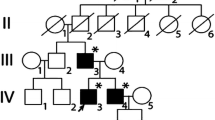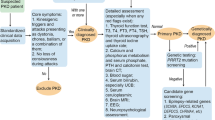Abstract
The pathogenesis of primary paroxysmal kinesigenic dyskinesia (PKD) remains unclear, and channelopathy is a possibility. In a pilot study, we found that PKD patients had abnormal exercise test (ET) results. To investigate the ET performances in patients affected by PKD, and the role of the channelopathies in the pathogenesis of PKD, we compared the ET results of PKD patients, control subjects, and hypokalemic periodic paralysis (HoPP) patients, and we analyzed ET changes in 32 PKD patients before and after treatment. Forty-four PKD patients underwent genetic testing for the PRRT2, SCN4A, and CLCN1 genes. Sixteen of 59 (27%) patients had abnormal ET results in the PKD group, while 28 of 35 (80%) patients had abnormal ET results in the HoPP group. Compared with the control group, the PKD group showed a significant decrease in the compound muscle action potential (CMAP) amplitude and area after the long ET (LET), while the HoPP group showed not only greater decreases in the CMAP amplitude and area after the LET but also greater increases in the CMAP amplitude and area immediately after the LET. The ET parameters before and after treatment were not significantly different. Nine of 44 PKD patients carried PRRT2 mutations, but the gene abnormalities were unrelated to any ET parameter. The PKD group demonstrated an abnormal LET result by electromyography (EMG), and this abnormality did not seem to correlate with the PRRT2 variant or sodium channel blocker therapy.

Similar content being viewed by others
Availability of data and material
The corresponding author can provide all the data and material about the manuscript.
Code availability
Not applicable.
Abbreviations
- CMAP:
-
Compound muscle action potential
- EMG:
-
Electromyography
- ET:
-
Exercise test
- HoPP:
-
Hypokalemic periodic paralysis
- LET:
-
Long exercise test
- PED:
-
Paroxysmal exertion-induced dyskinesia
- PKD:
-
Paroxysmal kinesigenic dyskinesia
- PP:
-
Periodic paralysis
- PRRT2:
-
Proline-rich transmembrane protein 2
- SET:
-
Short exercise test
References
Ohmori I, Ohtsuka Y, Ogino T, Yoshinaga H, Kobayashi K, Oka E (2002) The relationship between paroxysmal kinesigenic choreoathetosis and epilepsy. Neuropediatrics 33(1):15–20
Bathia KP, Soland VL, Bhatt MH, Quinn NP, Marsden CD (1997) Paroxysmal exercise-induced dystonia: eight new sporadic cases and a review of the literature. Mov Disord 12(6):1007–1012
Guerrini R, Sanchez-Carpintero R, Deonna T, Santucci M, Bhatia KP, Moreno T et al (2002) Early-onset absence epilepsy and paroxysmal dyskinesia. Epilepsia 43(10):1224–1229
Margari L, Presicci A, Ventura P, Margari F, Perniola T (2005) Channelopathy: Hypothesis of a common pathophysiologic mechanism in different forms of paroxysmal dyskinesia. Pediatr Neurol 32:229–235
Lee W-L, Tay A, Ong H-T, Goh LM, Monaco AP, Szepetowski P (1998) Association of infantile convulsions with paroxysmal dyskinesias (ICCA syndrome): confirmation of linkage to human chromosome 16p12-q12 in a Chinese family. Hum Genet 103(5):608–612
Browne DL, Gancher ST, Nutt JG, Brunt ER, Smith EA, Kramer P et al (1994) Episodic ataxia/myokymia syndrome is associated with point mutations in the human potassium channel gene, KCNA1. Nat Genet 8(2):136–740
Ophoff RA, Terwindt GM, Vergouwe MN, van Eijk R, Oefner PJ, Hoffman SM et al (1996) Familial hemiplegic migraine and episodic ataxia type-2 are caused by mutations in the Ca2+ gene CACNL1A4. Cell 87(3):543–552
Chen WJ, Lin Y, Xiong ZQ, Wei W, Ni W, Tan GH, Guo SL, He J, Chen YF, Zhang QJ, Li HF, Lin Y, Murong SX, Xu J, Wang N, Wu ZY (2011) Exome sequencing identifies truncating mutations in PRRT2 that cause paroxysmal kinesigenic dyskinesia. Nat Genet 43(12):1252–1255
Li J, Zhu X, Wang X, Sun W, Feng B, du T, Sun B, Niu F, Wei H, Wu X, Dong L, Li L, Cai X, Wang Y, Liu Y (2012) Targeted genomic sequencing identifies PRRT2 mutations as a cause of paroxysmal kinesigenic choreoathetosis. J Med Genet 49(2):76–78
Luo C, Chen Y, Song W, Chen Q, Gong QY, Shang HF (2013) Altered intrinsic brain activity in patients with paroxysmal kinesigenic dyskinesia by PRRT2 mutation. Neurol Sci 34:1925–1931. https://doi.org/10.1007/s10072-013-1408-7
Margari L, Perniola T, Illiceto G, Ferrannini E, De Iaco MG, Presicci A et al (2000) Familial paroxysmal exercise-induced dyskinesia and benign epilepsy: a clinical and neurophysiological study of an uncommon disorder. Neurol Sci 21:165–172
Hsu WY, Liao KK, Tseng YJ, Kwan SY, Chen RS, Lin YY (2013) Reduced postmovement cortical inhibition in patients with paroxysmal kinesigenic dyskinesia. Neurology 81:353–360
Tomita H, Nagamitsu S, Wakui K, Fukushima Y, Yamada K, Sadamatsu M et al (1999) Paroxysmal kinesigenic choreoathetosis locus maps to chromosome 16p11.2-q12.1. Am J Hum Genet 65(6):1688–1697
Bennet LB, Roach ES, Bowcock AM (2000) A locus for paroxysmal kinesigenic dyskinesia maps to human chromosome 16. Neurol 54(1):125–130
Auberger G, Ratzlaff T, Lunkes A, Nelles A, Leube HW, Binkofski F et al (1996) A gene for autosomal dominant paroxysmal choreoathetosis/spasticity (CSE) maps to the vicinity of a potassium channel gene clusteron chromosome 1p, probably within 2 cM between D1S443 and D1S187. Genomics 31:90–94
Valente EM, Spacey SD, Wali GM, Bhatia KP, Dixon PH, Wood NW et al (2000) A second paroxysmal kinesigenic choreoathetosis locus (EKD2) mapping on 16q13-q22.1 indicates a family of genes which give rise to paroxysmal disorders on human chromosome 16. Brain 123:2040–2045
Spacey SD, Valente EM, Wali GM, Warner TT, Jarman PR, Schapira AH et al (2002) Genetic and clinicalheterogeneity in paroxysmal kinesigenic dyskinesia: evidence for a third EKD gene. Mov Disord 17(4):717–725
Ebrahimi-Fakhari D, Saffari A, Westenberger A, Klein C (2015) The evolving spectrum of PRRT2-associated paroxysmal diseases. Brain 138(Pt 12):3476–3495
Erro R, Bhatia KP, Espay AJ, Striano P (2017) The epileptic and non-epileptic spectrum of paroxysmal dyskinesias: channelopathies, synaptopathies, and transportopathies. Mov Disord 32(3):310–318. https://doi.org/10.1002/mds.26901
Kuntzer T, Flocard F, Vial C, Kohler A, Magistris M, Labarre-Vila A, Gonnaud PM, Ochsner F, Soichot P, Chan V, Monnier G (2000) Exercise test in muscle channelopathies and other muscle disorders. Muscle Nerve 23:1089–1094
Fournier E, Arzel M, Sternberg D, Vicart S, Laforet P, Eymard B, Willer JC, Tabti N, Fontaine B (2004) Electromyography guides toward subgroups of mutations in muscle channelopathies. Ann Neurol 56:650–661
Ji F, Wang K, Luo BY, Ke Q (2017) Application of exercise test in patients with paroxysmal kinesigenic dyskinesia. Chin J Neurol 50(7):526–530
Bruno MK, Hallett M, Gwinn-Hardy K, Sorensen B, Considine E, Tucker S, Lynch DR, Mathews KD, Swoboda KJ, Harris J, Soong BW, Ashizawa T, Jankovic J, Renner D, Fu YH, Ptacek LJ (2004) Clinical evaluation of idiopathic paroxysmal kinesigenic dyskinesia: new diagnostic criteria. Neurology 63(12):2280–2287
Sansone V, Meola G, Links T, Panzeri M, Rose MR (2008) Treatment for periodic paralysis. Cochrane Database Syst Rev (1):CD005045. https://doi.org/10.1002/14651858.CD005045.pub2
Ding ZY, Liu MS, Cui LY (2007) VaIue of exercise test in the diagnosis of 18 patients with periodic paralysis. Chin J Neurol 40(4):242–245
Zhou HY, Zhan FX, Tian WT, Zhang C, Wang Y, Zhu ZY, Liu XL, Xu YQ, Luan XH, Huang XJ, Chen SD, Cao L (2018) The study of exercise tests in paroxysmal kinesigenic dyskinesia. Clin Neurophysiol 129(11):2435–2441
McGovern EM, Roze E, Counihan TJ (2018) The expanding spectrum of paroxysmal movement disorders: update from clinical features to therapeutics. Curr Opin Neurol 31(4):491–497
Heron SE, Dibbens LM (2013) Role of PRRT2 in common paroxysmal neurological disorders: a gene with remarkable pleiotropy. J Med Genet 50(3):133–139
Berardelli A, Rothwell JC, Hallett M, Thompson PD, Manfredi M, Marsden CD (1998) The pathophysiology of primary dystonia. Brain 121(Pt 7):1195–1212
Striano P, Lispi ML, Gennaro E, Madia F, Traverso M, Bordo L, Aridon P, Boneschi FM, Barone B, Bernardina B, Bianchi A, Capovilla G, de Marco P, Dulac O, Gaggero R, Gambardella A, Nabbout R, Prud'homme JF, Day R, Vanadia F, Vecchi M, Veggiotti P, Vigevano F, Viri M, Minetti C, Zara F (2006) Linkage analysis and disease models in benign familial infantile seizures: a study of 16 families. Epilepsia 47(6):1029–1034
Author information
Authors and Affiliations
Contributions
All authors contributed to the study conception and design. Material preparation, data collection, and analysis were performed by Fang Ji, Qing Ke, and Ben-yan Luo. The first draft of the manuscript was written by Fang Ji and Kang Wang, and all authors commented on previous versions of the manuscript. All authors read and approved the final manuscript.
Corresponding authors
Ethics declarations
Conflict of interest
The authors declare no competing interests.
Ethical approval
We confirm that we have read the Journal’s position on issues involved in ethical publication and affirm that this report is consistent with those guidelines.
Consent to participate
Informed consent was obtained from all individual participants included in the study.
Consent for publication
All individual participants signed informed consent regarding publishing their data and photographs.
Additional information
Publisher’s note
Springer Nature remains neutral with regard to jurisdictional claims in published maps and institutional affiliations.
Rights and permissions
About this article
Cite this article
Ji, F., Ke, Q., Wang, K. et al. Exercise test for patients with new-onset paroxysmal kinesigenic dyskinesia. Neurol Sci 42, 4623–4628 (2021). https://doi.org/10.1007/s10072-021-05118-0
Received:
Accepted:
Published:
Issue Date:
DOI: https://doi.org/10.1007/s10072-021-05118-0




